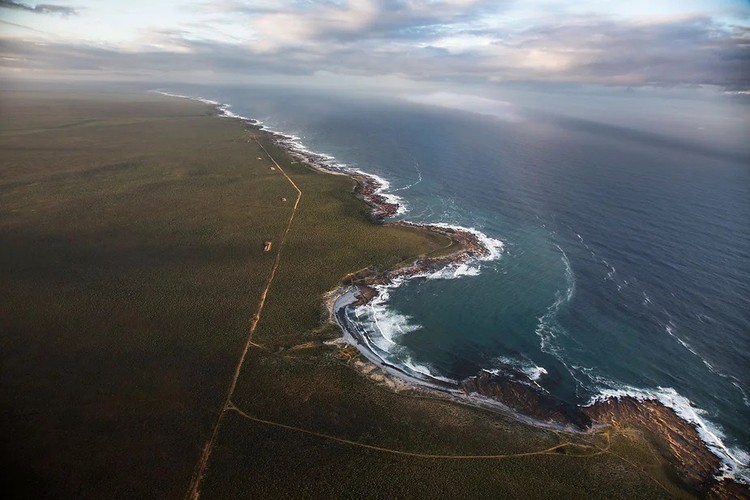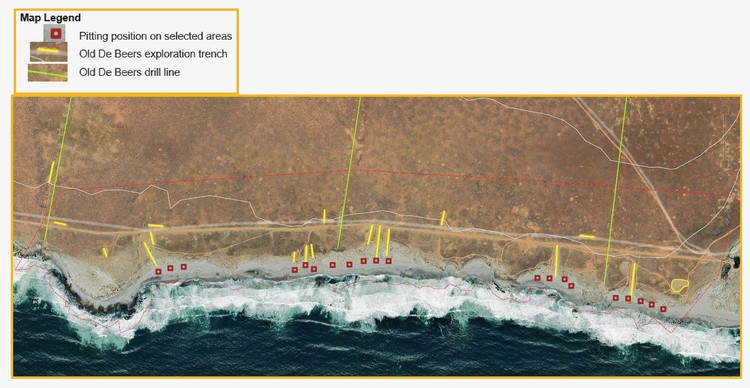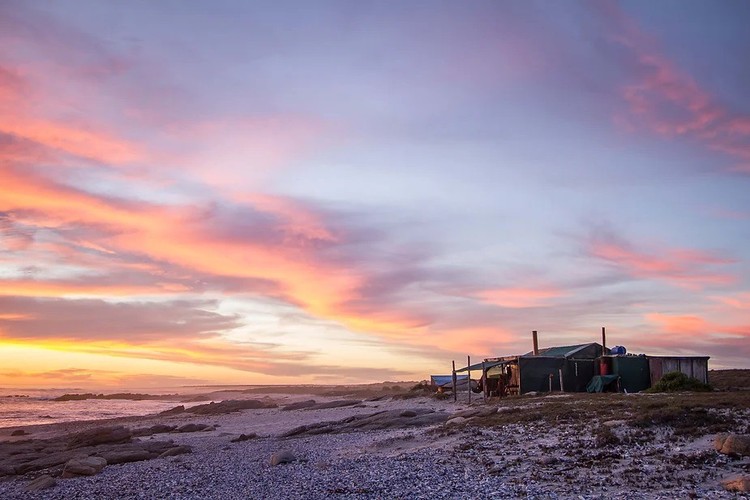Mining companies eye the last unspoilt strip of the Western Cape’s west coast
Concerns over cumulative impact of new prospecting
The Karoetjies Kop 150 coastal area where prospecting applications have been submitted. Environmentalists says it should be left “untouched and raw”, “beautiful and pristine”. Photo: Sacha Specker
- Approval of two applications to prospect on the coast between the Olifants River and the Northern Cape border are pending.
- Kotze West Coast Mining wants to prospect for diamonds and Nekwana Trading Enterprise wants to prospect for heavy minerals, kaolin and gemstones.
- Environmentalists have raised the alarm over the cumulative effect of different companies prospecting on the same property.
- No environmental assessment of the combined effects has been done.
The last, relatively pristine section of Western Cape coastline between the Olifants River and the Northern Cape border is threatened by two new mining-related applications.
The applications to the Department of Mineral Resources and Energy (DMRE) are for prospecting rights on the farm Karoetjies Kop 150, which extends six kilometres inland and 15km along the coast north of the Soutriver.
Kotze West Coast Mining wants to prospect for diamonds along the coastline, targeting places where diamond giant De Beers had excavated huge exploration trenches during the 1970s.
Nekwana Trading Enterprise (Pty) Ltd wants the inland prospecting rights as it eyes the possibility of extracting heavy minerals, kaolin and gemstones.
Environmentalists and residents have raised the alarm over a “tyranny of small decisions”, where numerous prospecting and mining applications and other development activities are individually approved by the government, without a proper assessment of their cumulative impact on the environment.
In its acceptance letter to Nekwana, DMRE says the company is required to “consult” with the department’s regional office or the diamond prospector about operations on the same property. Yet there is no requirement for a combined impact assessment of the two operations.
Professor emeritus Merle Sowman, former head of Department of Environmental and Geographical Science at the University of Cape Town, has repeatedly called for a strategic environmental assessment of the cumulative impacts of the expanding mining footprint along the entire West Coast.
She has warned that applications are being assessed on an individual basis without the government understanding the overall impact and net effect of all its various approvals.
Sowman says an overall, long-term and strategic decision-making process to guide where and when human activities can occur in South Africa’s ocean areas is underway, as required by the Marine Spatial Planning Act, which came into effect in 2021.
Yet because so many approvals have already been given for prospecting and mining applications, as well as other coastal developments, she says, an overarching strategic environmental planning process to facilitate sustainable development in the west coast will be undermined.
“It’s very worrying. There is massive pressure to allow more mining because the government sees this as economic growth potential, but no one is seeing the big picture,” she says.
Nekwana’s application
Nekwana Trading Enterprise (a company with a Polokwane, Limpopo postal address) wants to prospect for sillimanite, monazite, manganese ore, leucoxene, kaolin (clay) and garnets.
In its documentation, the company states that part of the prospecting work will involve drilling operations with boreholes limited to a depth of 20 metres. Twelve boreholes will be drilled initially to test target areas with up to ten or so more boreholes, depending on initial results.
The company says mining already contributes to the economies of surrounding towns, such as Nuwerus, Bitterfontein, Lepelsfontein and Rietpoort, and it will attract foreign investment through transportation and beneficiation. It says it will improve social cohesion for local communities.
The company says mining operations will boost local business and SMMEs and reduce youth and general unemployment.
It says a one kilometre “buffer zone”, where no drilling or activity will take place, will be placed around the river estuary and coastline.
Its final Basic Assessment Report and Environmental Management Programme documentation, including public comment, was submitted to DMRE on 19 May.
Proposed select target areas for new diamond prospecting, marked in red, at Karoetjies Kop 150. The yellow lines show old De Beers exploration trenches dating from the 1970s. Source: Kotze West Coast Mining, Draft Basic Assessment Report and Environmental Management Programme.
Kotze’s application
Kotze West Coast Mining (Kotze), based in Koekenaap, wants to prospect for “general” and “alluvial” diamonds on 296 hectares and the adjacent surf zone.
Its application was accepted in April. A draft Basic Assessment Report and Environmental Management Programme was released in June to interested and affected parties for comment, closing 15 July.
Kotze says it is applying for the area where De Beers/West Coast Resources held diamond prospecting rights in the surf zone – up to about 32 metres out to sea from the low water mark, and an average 800m wide coastal strip.
In December 2022, De Beers/West Coast Resources rights lapsed, and Kotze took the opportunity to apply for a new prospecting right over a small portion of the historic right.
“The only land use [in the area] is uncontrolled recreational activities with ad hoc campsites during the crayfish season … The environmental impact will be the same as for the informal campsites,” argues Kotze.
It says there will be no prospecting during the summer and Easter holidays and all excavations will be made safe to allow for open access during these periods.
“The presence of an authorised and environmentally responsible company on site will also help to mitigate the problem of illegal diggers, crayfish poaching, littering, illegal hunting, and plant (firewood) collection, a common occurrence along the west coast,” Kotze states.
According to the company, the preliminary evaluation will involve 20 sample pits with a footprint of 11 by eight metres and 6.5-metres deep. The pits will be filled and rehabilitated after the assessment.
If the results are promising, bulk sampling will be done from much bigger trenches, but this will involve additional authorisation, including a different environmental impact assessment and specialist studies.
Environmentalists voice concerns
Mike Schlebach, managing director of not-for-profit organisation Protect the West Coast (established in 2020) writes on its website that the entire West Coast is in “danger of becoming one massive mining site, all the way from Lambert’s Bay to the Namibian border” – more than 500km of coast.
Environmentalists say that where prospecting is approved, mining permits are inevitable if the value of deposits is deemed profitable.
Communications specialist Miles Masterson wrote on the website: “While not quite as disruptive as full-scale mining operations, the prospecting activities, such as collecting sediment samples and conducting heavy mineral separation, may involve the digging up and disturbance of coastal ecosystems and habitats. Moreover, given the mineral-rich quality of the area, the likelihood of these prospecting activities leading to actual mining is extremely high … in this pristine, untouched coastal zone.”
Schlebach describes coastal zone mining as “an outdated and destructive form of mining, which rips up beaches to extract minerals for everyday use such as cosmetics with little to no rehabilitation”.
“It means the loss of heritage sites, the degradation of biodiverse areas and fragile ecosystems, the pollution of the surrounding marine environments, the loss of livelihood to local fishers and a general decline in nearby communities.”
Allen Lyons, a retired geologist and former chair of the Strandfontein Ratepayers Association, says, “It’s a bit like a feeding frenzy, and we are not winning any battles. It’s also a very expensive process, and by the time any of our appeals reach the minister’s desk, the fight is usually already lost.”
Old rustic huts are still scattered over the Karoetjies Kop 150 farm’ coastal area. They are used by surfers and other travellers to the West Coast for shelter. Photo: Ant Fox
Next: UCT should not host anti-gay professor
Previous: No water, toilets or electricity in multi-million rand Eastern Cape taxi rank
© 2023 GroundUp. This article is licensed under a Creative Commons Attribution-NoDerivatives 4.0 International License.
You may republish this article, so long as you credit the authors and GroundUp, and do not change the text. Please include a link back to the original article.
We put an invisible pixel in the article so that we can count traffic to republishers. All analytics tools are solely on our servers. We do not give our logs to any third party. Logs are deleted after two weeks. We do not use any IP address identifying information except to count regional traffic. We are solely interested in counting hits, not tracking users. If you republish, please do not delete the invisible pixel.





